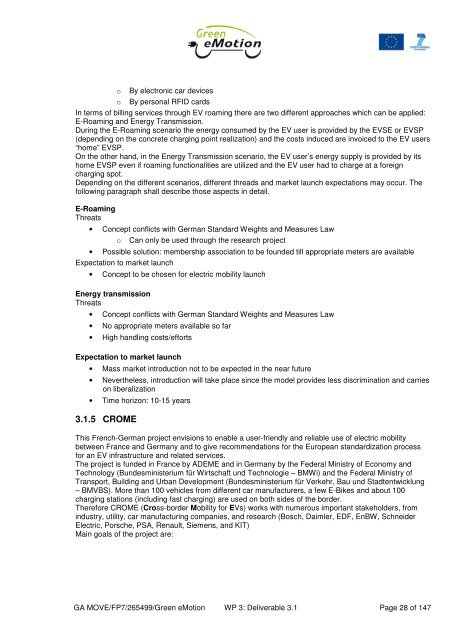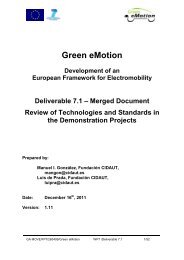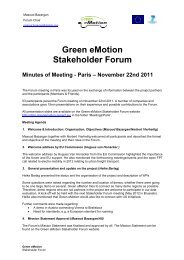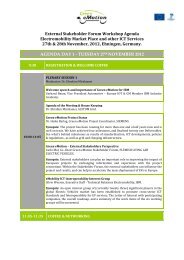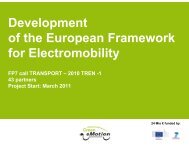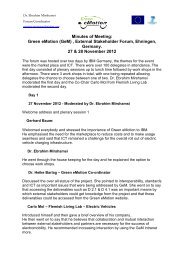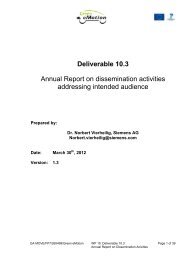Deliverable 3.1 Business Analysis - Green eMotion Project
Deliverable 3.1 Business Analysis - Green eMotion Project
Deliverable 3.1 Business Analysis - Green eMotion Project
You also want an ePaper? Increase the reach of your titles
YUMPU automatically turns print PDFs into web optimized ePapers that Google loves.
o By electronic car devices<br />
o By personal RFID cards<br />
In terms of billing services through EV roaming there are two different approaches which can be applied:<br />
E-Roaming and Energy Transmission.<br />
During the E-Roaming scenario the energy consumed by the EV user is provided by the EVSE or EVSP<br />
(depending on the concrete charging point realization) and the costs induced are invoiced to the EV users<br />
“home” EVSP.<br />
On the other hand, in the Energy Transmission scenario, the EV user’s energy supply is provided by its<br />
home EVSP even if roaming functionalities are utilized and the EV user had to charge at a foreign<br />
charging spot.<br />
Depending on the different scenarios, different threads and market launch expectations may occur. The<br />
following paragraph shall describe those aspects in detail.<br />
E-Roaming<br />
Threats<br />
• Concept conflicts with German Standard Weights and Measures Law<br />
o Can only be used through the research project<br />
• Possible solution: membership association to be founded till appropriate meters are available<br />
Expectation to market launch<br />
• Concept to be chosen for electric mobility launch<br />
Energy transmission<br />
Threats<br />
• Concept conflicts with German Standard Weights and Measures Law<br />
• No appropriate meters available so far<br />
• High handling costs/efforts<br />
Expectation to market launch<br />
• Mass market introduction not to be expected in the near future<br />
• Nevertheless, introduction will take place since the model provides less discrimination and carries<br />
on liberalization<br />
• Time horizon: 10-15 years<br />
<strong>3.1</strong>.5 CROME<br />
This French-German project envisions to enable a user-friendly and reliable use of electric mobility<br />
between France and Germany and to give recommendations for the European standardization process<br />
for an EV infrastructure and related services.<br />
The project is funded in France by ADEME and in Germany by the Federal Ministry of Economy and<br />
Technology (Bundesministerium für Wirtschaft und Technologie – BMWi) and the Federal Ministry of<br />
Transport, Building and Urban Development (Bundesministerium für Verkehr, Bau und Stadtentwicklung<br />
– BMVBS). More than 100 vehicles from different car manufacturers, a few E-Bikes and about 100<br />
charging stations (including fast charging) are used on both sides of the border.<br />
Therefore CROME (Cross-border Mobility for EVs) works with numerous important stakeholders, from<br />
industry, utility, car manufacturing companies, and research (Bosch, Daimler, EDF, EnBW, Schneider<br />
Electric, Porsche, PSA, Renault, Siemens, and KIT)<br />
Main goals of the project are:<br />
GA MOVE/FP7/265499/<strong>Green</strong> <strong>eMotion</strong> WP 3: <strong>Deliverable</strong> <strong>3.1</strong> Page 28 of 147


